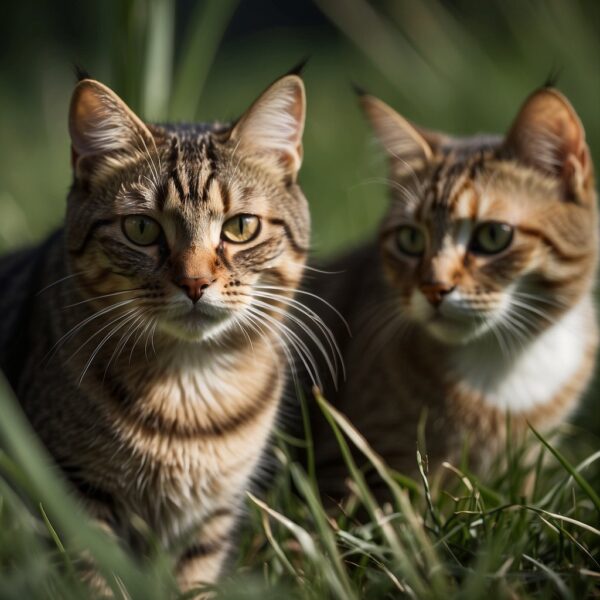
Cats and Stalking: Why Cats Stalk
Stalking is an intrinsic part of a cat’s behavior, stemming from their natural predatory instincts. Even domestic cats, who are well-fed and do not need to hunt for survival, often exhibit stalking behaviors. This can manifest in various ways, from chasing after toys to pouncing on unsuspecting house guests. These actions are not just whimsical play; they are deeply rooted in the feline’s DNA, a reflection of their ancestors’ need to hunt for food.
Despite their domestication, cats retain much of their wild ancestors’ skill set, including the art of the stalk. This behavior satisfies their innate desire to hunt and provides necessary mental and physical stimulation. When cats do not have an appropriate outlet for these natural behaviors, it can lead to issues like boredom or frustration. Hence, understanding and catering to these instincts is crucial for any cat parent who wants to ensure their feline companion remains happy and healthy.
Key Takeaways
- Stalking is a natural, instinctive behavior in cats.
- Appropriate outlets for stalking can prevent boredom and frustration.
- Understanding cat stalking behavior is crucial for their well-being.
Understanding Cat Stalking Behavior
Cat stalking behavior stems from their natural predatory instincts and is an integral part of their inherent hunting repertoire, with behaviors manifesting as a combination of instinct, learning, and environmental factors.
The Science Behind the Stalk
Stalking in cats is a behavior largely driven by their genetic predisposition, closely linking domestic cats to their wild ancestors. These predatory instincts are hardwired into their DNA, making the stalk a fundamental component of their natural behavior. This hunting instinct is observable in the careful movements and strategic positioning of felines as they prepare to pounce on their prey.
Observing the Stalking Ritual
During a stalking sequence, a cat’s body language becomes a telltale sign of its focused intent. Their ears will pivot forward, tail may twitch slightly, and their entire body engages in a stealthy dance of stalking and pouncing. Observing this ritual in domestic cats offers insight into their innate predatory behaviors.
Environmental Factors Influencing Stalking
The environment plays a significant role in shaping a cat’s stalking behavior. Issues such as over-crowdedness or inadequate territory can exacerbate feelings of stress and frustration, leading to increased stalking as a means to claim and patrol their domain.
- Territorial: Cats may stalk more if they feel their territory is under threat.
- Stimulation: Lack of environmental enrichment may lead to stalking as an outlet for pent-up energy.
Health and Psychological Aspects
When stalking behavior becomes excessive, it may indicate underlying health or psychological issues. Cats that display signs of being overly agitated or anxious might experience higher stress levels, which in turn can lead to an escalation in stalking and other aggressive behaviors. A consultation with a vet or veterinary behaviorist can be crucial in these cases.
Common Misconceptions About Cat Stalking
A common misconception is that stalking in domesticated cats is a behavior that should be discouraged. In reality, stalking is a natural expression of a cat’s hunting instinct and should be understood and managed rather than suppressed.
Differentiating Playful Stalking from Aggressive Stalking
It’s essential to differentiate between stalking as playful behavior and stalking that may result in harm or danger. Playful stalking is often characterized by light-hearted biting and swatting, whereas aggression might include growling and more intense biting. Redirected aggression and territorial aggression are forms of stalking behavior that can be concerning and may require intervention.
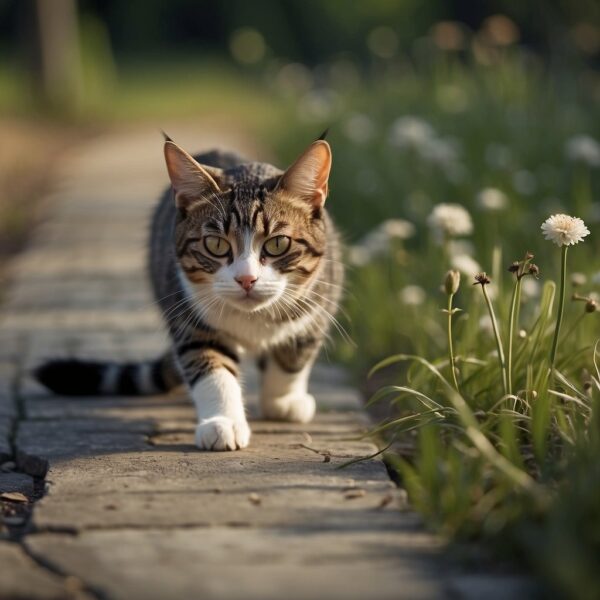
Fostering a Healthy Stalking Environment
Cats naturally exhibit stalking behavior, and it’s essential for cat parents to provide an environment that channels this instinct constructively. A well-thought environment can prevent boredom, encourage appropriate exercise, and maintain mental and physical health.
Creating a Stimulating Home Environment
A stimulating home environment is rich with opportunities for a cat to engage its senses and its hunting instincts. Cat trees and shelves can transform a room into a three-dimensional playground, allowing cats to climb and observe from elevated perches. Hidden nooks and puzzle feeders can also motivate cats to explore and ‘hunt’ for their food, providing both physical and mental stimulation.
The Role of Interactive Play
Interactive playtime is paramount in a cat’s daily routine, allowing safe and controlled outlets for their stalking impulses. Feather wands, laser pointers, and mouse toys not only entice cats to chase and pounce but also strengthen the bond between cats and their humans. Regularly scheduled play sessions will help expend a cat’s energy in a positive way, and cat parents should aim for at least two 15-minute periods of interactive play each day.
Dealing with Unwanted Stalking Behavior
When a cat exhibits stalking behavior towards humans or other inappropriate targets, behavior modification is necessary. Instead of punishment, which can lead to fear or aggression, positive reinforcement is a more effective strategy. Redirecting the cat’s attention to appropriate toys during moments of unwanted stalking and rewarding them when they engage with these toys can help reshape their behavior. Frequent playtime and attention can also alleviate the cat’s need to display these behaviors inappropriately.
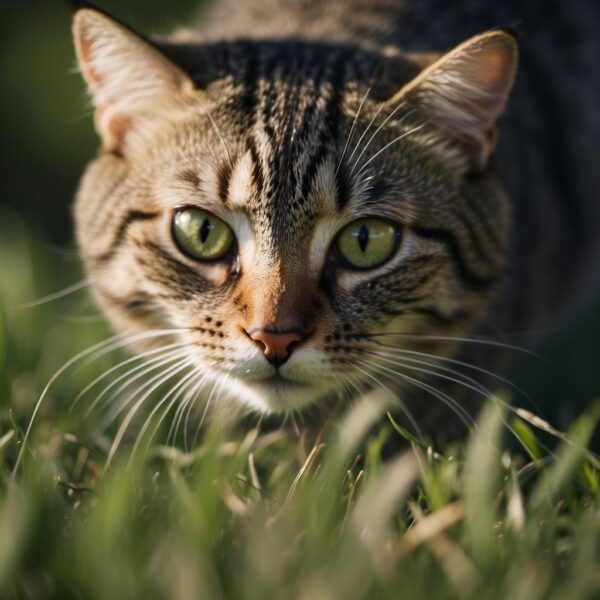
The Importance of Prey Simulation Toys
Toys designed to simulate prey, such as mouse toys and feather wands, are essential in mirroring the outdoor environment within the safe confines of a domestic setting. They cater to a cat’s natural inclination to stalk and hunt, providing essential mental stimulation and encouraging physical activity.
Laser pointers can serve as an excellent tool for simulating the unpredictable movements of prey, captivating a cat’s attention and engaging their predatory instincts. However, it’s important to occasionally let the cat ‘catch’ a physical object to prevent frustration, as the red dot of a laser pointer can never be truly caught.
Scratching posts are another vital aspect of prey simulation, as they allow cats to exercise the sharpening of their claws—an activity that is crucial for a predator in maintaining their hunting tools. Moreover, scratching acts as a form of territory marking, which is another inherent behavior related to their predatory nature.
Here is a brief classification of these toys:
- Mouse Toys: Enhance stealth and pounce abilities.
- Feather Wands: Stimulate chase and leap actions.
- Scratching Posts: Maintain claws and denote territory.
The provision of such toys ensures that domestic cats, far removed from their wild predators and the need to defend territory, can still express these fundamental behaviors. This practice leads to well-adjusted cats and reduces potential behavioral issues associated with pent-up energy or boredom.
Training and Behavior Modification Techniques
To address and manage feline stalking behaviors effectively, it is essential to employ a range of training and behavior modification techniques. These methods focus on channeling a cat’s natural instincts in a positive direction, reducing undesirable aggression, and recognizing when professional intervention is necessary.
Engaging with Your Cat’s Predatory Instinct
Cats have an inherent predatory instinct that can often manifest as stalking behavior. Introduce regular play sessions that mimic hunting activities to satisfy this need. Use toys that stimulate the cat’s urge to chase, pounce, and capture. Engaging cats in such activities for at least 10-15 minutes a couple of times a day can help mitigate stress and prevent boredom.
Managing Aggression and Redirecting Energy
When cats display aggression or signs of agitation, it is crucial to redirect that energy in a healthy manner. Offering a variety of toys and creating climbing spaces can help. If a cat exhibits redirected aggression, identify the source of stress or agitation and remove it if possible. Basic tips for redirecting a cat’s energy involve providing alternative outlets such as scratching posts or interactive toys.
Understanding the Need for Professional Support
If the stalking behavior is persistent and accompanied by signs of an agitated or anxious disposition, seeking the advice of a veterinary behaviorist or an animal behaviorist is advised. They are trained to understand complex behavior issues and can work with guardians to develop tailored modification plans that may include environmental changes, behavioral therapy, and sometimes medication.
Spay/Neuter and Its Role in Behavioral Management
Spaying or neutering your cat can play a significant role in managing behavioral issues. It may reduce the likelihood of certain types of aggression and can help lessen the intensity of a cat’s hunting instinct. A veterinarian can advise on the appropriate age to neuter and discuss any behavior changes that may result from the procedure.
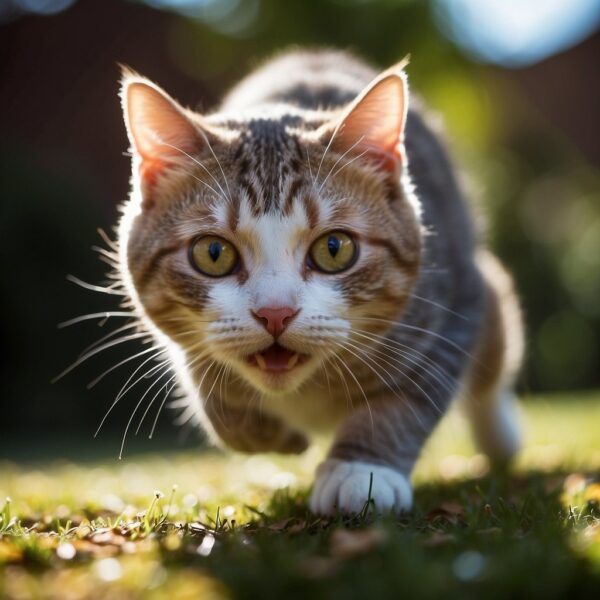
Integrating with Other Pets and Their Environment
Proper integration and management of a cat’s territorial behavior is essential when introducing new pets or adjusting to changes in their environment. It fosters harmony among pets and helps prevent stress-related behaviors.
Introducing New Pets and Respect for Territory
Cats are distinctly territorial and may exhibit distress or aggression when a new pet infringes on their perceived territory. Ensuring each cat has access to their own resources such as food bowls, water, and litter boxes can ease tension. Slowly introducing new pets through a process that respects the established cat’s territory will help minimize territorial aggression. Over time, with controlled and gradual exposure, cats can become accustomed to each other’s presence without immediate access, reducing the chances of conflict.
Coping with Inter-Pet Aggression
Inter-pet aggression, such as territorial and redirected aggression, can manifest when a cat feels their domain is at risk. Identifying aggression early and responding with appropriate measures is crucial. Strategies include providing separate areas for each pet, avoiding competition over resources, and monitoring interactions closely. Use positive reinforcement to reward peaceful behavior and consider consulting a veterinarian or a behaviorist if aggression persists.
Utilizing Play to Encourage Positive Interactions
Channeling a cat’s energy into playtime can mitigate issues like play aggression and help integrate pets. Offering various toys that stimulate a cat’s instinct to stalk and pounce can redirect their focus away from other pets. Engaging in interactive play provides exercise and mental stimulation, reducing the chances of territorial disputes. Supervised joint play sessions can also foster positive associations between pets, reinforcing peaceful coexistence.
cat stalking Conclusion
Stalking behavior in cats is a natural manifestation of their predatory instincts. It often reflects a cat’s need for mental and physical stimulation. Cat lovers can observe these behaviors as a sign of a healthy, energetic pet. It is important, however, to ensure these actions remain playful and do not escalate into aggression.
Regular play sessions with appropriate toys can redirect stalking behaviors towards a more acceptable outlet, preventing boredom and frustration. Toys that mimic prey movements, such as feather wands can be particularly effective. This form of engagement not only satisfies a cat’s hunting instincts but also helps in expending pent-up energy in a controlled environment.
For cat parents, understanding this behavior is critical for forming a positive human-pet relationship. Engaging play, consistent interaction, and a variety of stimulation sources are recommended to maintain a cat’s well-being. Should stalking behavior become problematic, consultation with a veterinarian or an animal behaviorist is advisable to address any underlying issues.
In summary, when managed with care and insight, the stalking behavior of cats can be channeled into healthy play that benefits both the cat and their guardian.
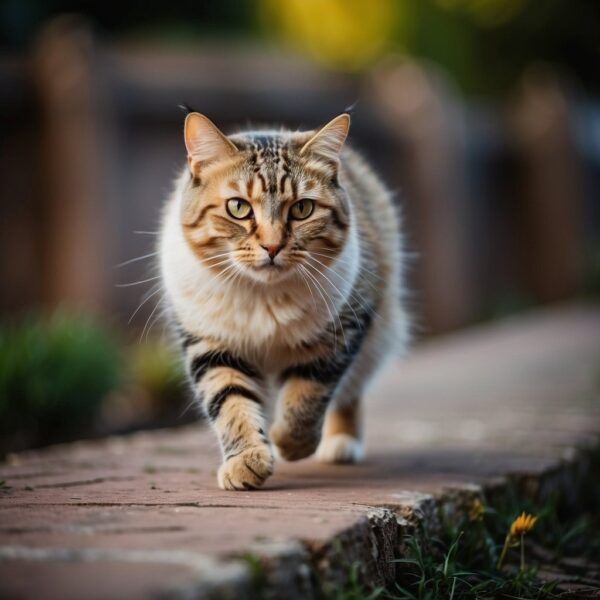
cats and stalking: Frequently Asked Questions
Understanding why cats engage in stalking behaviors can enhance the relationship between cat and guardian. This section addresses common inquiries about feline stalking behavior.
What behaviors indicate a cat is stalking, and how can I identify them?
Cats show stalking behavior through body language such as crouching low to the ground, moving slowly, and focusing intently with dilated pupils. An owner might notice their cat hiding behind objects, patiently waiting to make a surprise pounce.
Is stalking a natural instinct for cats, and what drives this behavior?
Stalking is an innate instinct for cats, driven by their predatory nature. This behavior is linked to their hunting habits, essential for survival in wild ancestors, and persists even in domesticated cats.
How should a guardian react when their cat exhibits stalking behavior towards them or others?
Cat parents should react positively to a cat’s stalking behavior, redirecting it towards appropriate play with toys instead of hands or feet. It’s an opportunity for bonding and providing the necessary mental and physical stimulation cats require.
What are the implications of stalking behavior for indoor versus outdoor cats?
For indoor cats, stalking behavior requires engagement through play to fulfill their hunting instincts, preventing potential boredom or frustration. Outdoor cats may express stalking behavior more naturally by pursuing prey, but this carries the risks of injury and predation.
How can you safely play with a cat to satisfy their stalking instincts?
Playing with interactive toys, like a wand toy, can mimic prey movements and satisfy a cat’s stalking instincts. Ensure playtime is controlled and avoid using fingers or toes as substitutes for toys to avoid accidental injuries.
Can changes in stalking behavior be indicative of health issues in cats?
Changes in a cat’s stalking behavior, such as an increase or decrease in the activity, can indicate health issues. Sudden lack of interest in stalking could signal conditions such as arthritis or other pain-related issues. Observant parents should consult a veterinarian if they notice significant changes.